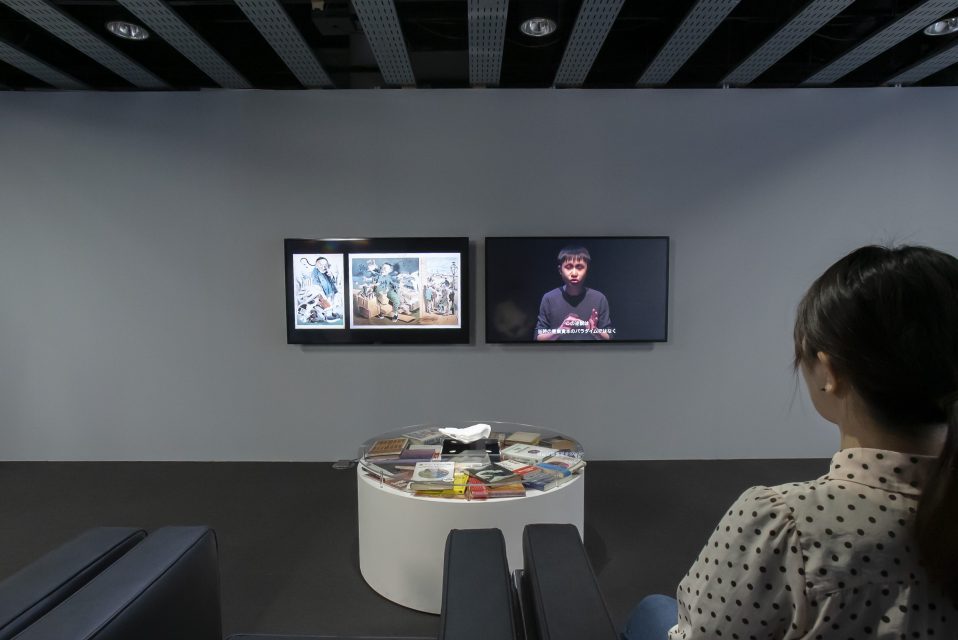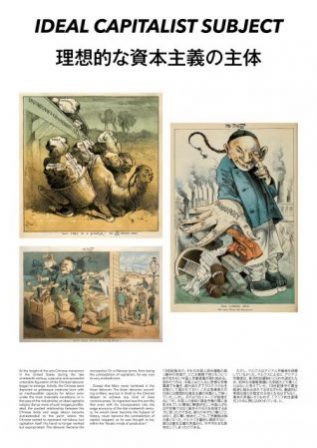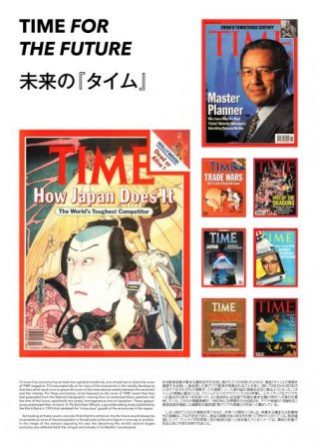IMAGE CRISIS
By Andrew Maerkle
 Asia the Unmiraculous (2018- ), lecture and video installation with digital prints on paper mounted on LED-illuminated acrylic, books, and magnetically levitated hand model. All images: Unless otherwise noted, photo Yasuhiro Tani, courtesy Yamaguchi Center for Arts and Media.
Asia the Unmiraculous (2018- ), lecture and video installation with digital prints on paper mounted on LED-illuminated acrylic, books, and magnetically levitated hand model. All images: Unless otherwise noted, photo Yasuhiro Tani, courtesy Yamaguchi Center for Arts and Media.
Born in Singapore in 1990, Ho Rui An works at the intersections of critical thinking, anthropology, film, and performance. Frequently taking the form of live lecture-performances that are documented and then integrated into installation environments, his works address topics ranging from the role of sweat in the imagining of the European colonial project to the dashcam as a new cinematic apparatus for the surveillance society era.
In late 2018, Ho participated in the exhibition “The Breathing of Maps” at the Yamaguchi Center for Arts and Media. Organized in conjunction with the Japan Foundation Asia Center, the exhibition examined the map as a symbolic product of modernization in Asia, and a source of the national geobodies that condition how we live, work, and engage language and culture. Ho presented a new work in Yamaguchi, Asia the Unmiraculous (2018- ), which was produced for “The Breathing of Maps” in collaboration with the 12th Gwangju Biennale. Tying together a dizzying array of historical, pop cultural, and journalistic references, the work unpacks the racialized rhetoric surrounding the postwar Asian economic miracle and the Asian financial crisis of 1997, as well as the global financial crisis of 2007–08. Ho was on hand for the exhibition opening, where his lecture-performance had a two-night run at YCAM’s multimedia studio space.
ART iT traveled to Yamaguchi to see the performance and talk with Ho about Asia the Unmiraculous in relation to his broader practice.
“The Breathing of Maps” was on view at Yamaguchi Center for Arts and Media from December 15, 2018, to March 3, 2019.
I.
 Asia the Unmiraculous, installation view.
Asia the Unmiraculous, installation view.
ART iT: Yesterday as I was going through the exhibition I happened to come upon your work right as the hand in the display was taken away by the exhibition staff. Some children were playing around nearby and must have knocked it over. So by the time I actually looked at the work, there was no hand there.
This accident was significant to me as a manifestation by disappearance. A graphic representation of the invisible hand of the market was turned into an actual invisible hand in a way that had meaning only under those exact circumstances. But it was also a reminder of how difficult it is to visualize the world of finance. How did you approach this problem in conceiving Asia the Unmiraculous (2018- )?
HRA: Asia the Unmiraculous examines the ways we figure crisis—specifically the financial crisis that began in East and Southeast Asia in 1997, known today as the Asian financial crisis. It has always struck me that financial crisis is a very peculiar type of crisis, in that it doesn’t always provide an easily accessible site for us to grasp it at the level of our sense perception. A natural catastrophe has a very clearly marked disaster zone, but where do you go in the event of a financial crash? The cliché is the image of falling asset prices in the stock exchange. But of course what that image represents is not really the crisis itself. It’s more like a placeholder image for the crisis, which itself appears to resist representation.
Anyone who grew up in East and Southeast Asia in the 1990s and is part of the post-1989 generation would have been through two major financial crises before they hit the age of 20. It’s a strange thing to experience, because as a kid you’re aware that something terrible is happening, but the effects are not always directly sensible. Or they hit you much later, say, through hearing about workers getting retrenched or debt-ridden investors jumping off buildings. But even so, these effects are so distributed that it’s difficult to “return” to something like the origin of the crisis. So that was a primary question for me: How do we understand a crisis that begins primarily in the realm of abstraction, but at some point comes back to earth in very concrete ways?
An essay by the anthropologist Rosalind C. Morris, who researched spirit mediumship in Thailand in the 1990s, was instructive. Morris starts the essay by writing about her attempt at undertaking an ethnography of the financial crisis in Thailand in 1997 when the stock market crashed. One of the first things she did was to go to the stock exchange, but on the way there she heard an announcement that a well-known spirit medium was going to renounce his abilities at a public event and thus reveal how spirit mediums perform their magic. This event ended up becoming the subject of the essay—though Morris eventually arrives at a renewed understanding of the fantasy of the free market through her analysis of spirit mediumship. That is, if spirit mediumship is predicated on the medium’s complete disavowal of any memory of the event of possession, the market can also be considered a form of mediumship insofar as it is assumed to perfectly channel the spirit of the economy without any intervening consciousness whatsoever. So what happens when such powers of mediumship are disavowed, as in a financial crash?
It’s remarkable to me how the essay arrives at the subject of the market only by deferring a visit to the market. You can sense a similar trajectory in my lecture. To put it simply, I was trying to not go to the stock exchange. Instead, I went on a detour to seek out all kinds of images circulating in society through which the logic of free-marketization and financialization could be unpacked.
ART iT: Although there might have been individual stories, I don’t recall many works from the time of the Asian financial crisis that attempted to visualize it in a comprehensive way. In contrast, I would locate your work in a post–2008 financial crisis cultural context that is highly conscious of derivatives and subprime mortgages or other “disembodied” financial instruments, to use one of the terms from your lecture.
HRA: The thing about 1997 was that many of the countries in the region were also experiencing political crises as the financial crisis was happening. In retrospective accounts of the period the focus has been more on the political narrative than on the narrative of financial capitalism. This is something I allude to in the lecture. For one, what happened in Indonesia is often narrativized through the Reformasi movement and the fall of Suharto that followed the economic collapse of the country. Such narratives are centered more on Suharto than on the international networks of capital that propped him up.
Malaysia also experienced its own Reformasi movement following the ousting of Mahathir’s deputy Anwar Ibrahim. The movement didn’t bring down Mahathir and, in fact, Mahathir came out of the financial crisis stronger than before, especially after he was vindicated on his imposition of capital controls.
I find that the question of financialization tends to be eclipsed in our accounts of the political crises in the region at that time. So often the narrative takes authoritarianism as the primary subject of critique—which of course is absolutely valid in itself. But in pursuing my research into the time between 1997 and 1998, I wanted to understand how these political crises could be read through a transnational narrative of the financialization of these economies.
ART iT: This relates to allegory. Allegory is not such a fashionable word right now, but I think it’s important to use this unfashionable word when we talk about geopolitical constructs such as Europe or Asia in order to show that they are discourses with several centuries’ worth of accumulated baggage. Allegories help us visualize things that can’t be represented, but they also obscure underlying narratives. Take the allegory of liberal democracy, for example. The dominant narrative that was built up from the end of the Cold War to the presidency of George W Bush was that the free market and democracy go hand in hand, whereas the collapse of that allegory in the aftermath of the Bush presidency and the 2008 financial crisis has allowed a profusion of other narratives to emerge out of that void.
HRA: Allegory and narrative are closely related, and the form I work with is indeed a narrative form. Some might think the lecture format is didactic, and sometimes that is seen as a bad thing in contemporary art. But I think it’s become increasingly necessary that we seek new ways of visualizing or simply making sense of the complex systems that constitute global politics today. This is where a certain vernacular in contemporary art that emerged out of postminimalism and that valorizes fragmentation over narrativity reaches its limit—not least when we consider how the modus operandi of capitalism actually follows the exact same logic of fragmentation, of the disorientation of the senses, of the refusal of narrativity. This is also where expanded narrative forms like the lecture regain their currency, for they insist on trying to make sense of things in a time when the ruling capitalist class demands our atomization as mere individuals incapable of navigating complex and increasingly abstracted networks of power.


 Above: Asia the Unmiraculous, installation detail, courtesy Ho Rui An. Below: Performance view, Yamaguchi Center for Arts and Media, 2018.
Above: Asia the Unmiraculous, installation detail, courtesy Ho Rui An. Below: Performance view, Yamaguchi Center for Arts and Media, 2018.
ART iT: But of course one of the problems we face in contemporary art today is that the languages we come up with to critique the system are somehow entangled in or produced by the system. In order to critique financial capital, you already have to be implicated in the system of financial capital. Do you think of your work as a critical practice as such?
HRA: I think the lecture as a form itself opens up many modes of criticality. As much as I’m constructing narratives, a big part of the process also involves deconstructing or questioning established narratives. But I think it would be too ambitious to say that the lectures in themselves offer an escape from capitalism, because that’s obviously not what’s happening. The starting point of each lecture can be just a single question that I’m trying to answer. Even though each lecture might seem expansive in the sense that it appears to cover a wide range of contexts, the question that it asks is often very simple. For Asia the Unmiraculous, this is the question of the relationship between race and capitalism. Or you can even go back to the question I begin the lecture with, What is Asia? What is Asia in the context of these past 200 years of capitalist development, and how has the figure of Asia shifted against these developments? I approach the lecture as a form for opening up these conversations. I don’t necessarily end with a prescriptive conclusion or a call to action or a master plan to save the world from capitalism. The aspiration has always been to just look at certain issues or narratives that have been foreclosed by normativized modes of thinking about and acting upon the world. Because that is where we need to begin.
ART iT: This has become more prominent with rising concerns over the potential breakup of the European Union, but many Europeans seem to think of Europe as an ideal—an allegory of human rights and Enlightenment principles. Yet Asia does not have a particular allegory of itself. Asia is itself a concept that was imposed on the region from the outside by Europe, so if anything Asia has always been an allegory of empire, of a territory or market to be conquered and exploited. How can we talk about Asia from within Asia?
HRA: I think one of the most interesting developments in Europe in the past decade has been the exposure of European cultural unicity as a myth from the start. Despite their differences, ASEAN is often compared favorably with the EU, and ASEAN has always prided itself on being the most successful regional organization in the world after the EU. But of course when you actually look at ASEAN and Southeast Asia, you realize you have to begin from the premise that this is an extremely heterogeneous region with no basis for a common identity, and that any regional identity that does exist is largely the result of external factors such as World War II and the Cold War. We have always assumed that Europe is the opposite, but that illusion is starting to dissipate. You see it very clearly in the discourses of racialization within Europe itself, where the northern and western European states look at their southern and eastern counterparts through the same racialized lens with which they regarded their colonial subjects in an earlier time.
Even the way financial crises are named mobilizes deeply racialized signifiers. You can see that in the European sovereign debt crisis with the so-called PIGS economies: Portugal, Italy, Greece, Spain. They now embody the myth of the lazy native that was once thought of as being endemic to Southeast Asia. It’s exactly the same imaginary: they have too much sun, too much siesta, too many holidays, and that’s why the economy is in tatters.
The logic of racialization is thus not about Europe versus Asia. It is an ideological move that happens in the wake of a crisis that externalizes the discontents of late capitalism to a source of foreign origin while exonerating the ruling class and allowing the existing system to continue uninterrupted.
ART iT: On the flip side there are reactionary discourses in Asia and elsewhere that critique anything that is perceived to be “Western” as being imported and therefore invalid in the local context.
HRA: Yes, the “Asian values” discourse that Lee Kuan Yew championed, for one. Lee himself was not above the hypocrisy he often accused the West of. Even as he tried to reconstitute essentialist divisions between the Asian way of doing things and the Western way of doing things, he was ever ready to discard these distinctions in favor of taking a so-called pragmatic view when the situation called for it. In the lecture I quote an interview in which he says, “As long as it’s a good way of doing business, it doesn’t matter where it comes from.” He presented pragmatism as a way of transcending essentialist cultural oppositions, yet a contradiction arose each time the elder statesman indulged his prejudices and claimed that Asians, or specifically East Asians, are more pragmatic, thus racializing pragmatism.
It’s the same with how neoliberal economists speak of the market as this thing that dissolves cultural distinctions. They say the market isn’t Western or Asian. But at the same time, they claim that the Western world is somehow better at this market thing than Asian countries are. These are some of the contradictions in the discourses of universalization and particularization that I was trying to unpack in the work.
Ho Rui An: Image Crisis
